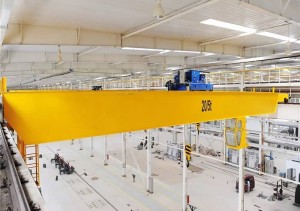
Underhung Bridge Crane for Small Workshop Space Saving
Introduction
An underhung bridge crane, also known as an under-running bridge crane, is a versatile lifting solution designed to operate on rails attached to the bottom flange of the runway beams. This unique structure provides excellent space efficiency, offering lower headroom requirements compared to top-running systems. As a result, the underhung bridge crane is ideal for facilities where ceiling height or structural clearance is limited.
Because of its adaptable design, the underhung bridge crane can be easily integrated into existing building frameworks without the need for extensive structural modification. It offers smooth and precise load handling, making it a practical choice for light to medium-duty operations.
Common applications include manufacturing workshops, automotive assembly lines, warehouses, and maintenance facilities, where flexibility, reliability, and efficient use of space are essential.
Features
The underhung bridge crane is a compact, efficient, and flexible lifting system designed to optimize workspace and streamline material handling. Its unique structural design and versatility make it an ideal solution for light to medium-duty lifting operations in manufacturing, warehousing, and logistics environments. Below are the key features of the underhung bridge crane:
1. Compact Structure and High Space Utilization
The underhung bridge crane can be directly installed on the existing beam frame of a factory or warehouse without requiring additional columns or supports. This suspended design saves valuable floor space, making it particularly suitable for facilities where maximizing workspace is essential. The compact layout ensures efficient use of the available height while maintaining strong lifting performance.
2. Flexible and Smooth Operation
This crane system supports multiple control modes, including pendant control, ground handle operation, and wireless remote control. Operators can easily switch between different modes according to work needs, achieving precise, stable, and safe movement. Its smooth operation allows the underhung bridge crane to adapt to various production processes seamlessly.
3. Easy Installation and Low Maintenance
Due to its lightweight suspended structure, installation is quick and does not require complex civil work. The system design minimizes wear on components, leading to lower maintenance requirements and reduced operational downtime.
4. Strong Applicability and Cost Efficiency
The underhung bridge crane is suitable for general light industrial use, assembly lines, and warehouse logistics. Its simple yet durable design keeps manufacturing and operational costs low, offering an affordable lifting solution without compromising reliability and safety.




Application
The 5 ton overhead crane is a highly versatile lifting solution widely used across multiple industries thanks to its compact structure, flexible movement, and reliable performance. It is especially suitable for operations that require precise handling and efficient workflow. Below are some of the main application areas:
1. Machinery Manufacturing Industry:
In mechanical production and assembly workshops, the 5 ton overhead crane is used for lifting and positioning machine parts, molds, and components. It effectively improves production efficiency, ensures operational safety, and reduces manual labor intensity during material transfer and assembly.
2. Warehousing and Logistics Industry:
The 5 ton overhead crane plays a key role in loading, unloading, stacking, and transporting goods. It is particularly suited for light to medium-duty operations, providing smooth movement and optimized space utilization in logistics centers and storage facilities.
3. Food Processing Industry:
With clean operation and precise control, the 5 ton overhead crane is ideal for handling raw materials and finished product packaging. Its pollution-free operation meets the hygiene and safety standards required in food production environments.
4. Assembly Workshops and Laboratories:
In precision assembly and laboratory environments, the 5 ton overhead crane ensures accurate and stable handling of delicate parts. Its fine positioning capability supports complex processes that demand consistency and high precision.
















